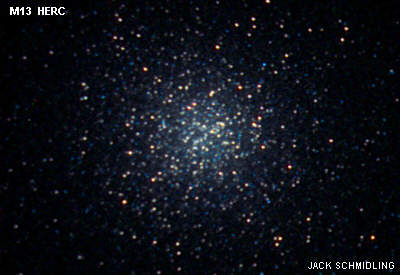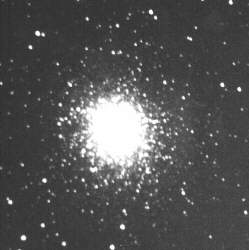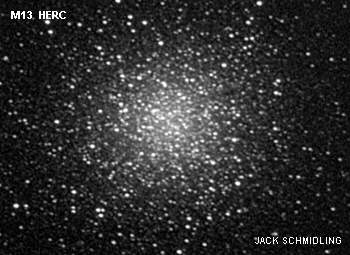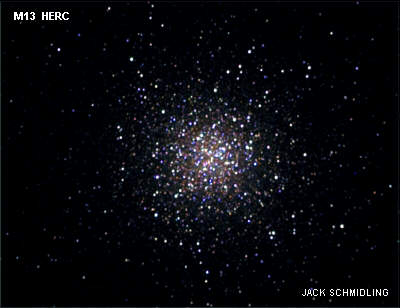![[m104]](m13t.jpg)
| Astrophotos | JSP Homepage |

M13 is probably the most looked at and most beautiful object that can be seen
in the Northern skies. Even modest amateur telescopes show it as a blazing ball
of stars. Again we can be glad that instruments have improved since the days of
Messier. When he cataloged this object as M13 in 1764, he described it as
a "nebula containing no stars". This is about what one sees in a pair of binoculars
today.
This color image not only shows that it contains so many stars that it just becomes a blob of light in the core with long exposure but further that the stars come in several different colors.
Because of burnout in photos, it is difficult to determine the exact number of stars, especially in the central core where they are most numerous, but 30,000 stars have actually been counted and estimates are that the cluster contains something like one million stars.
The total luminosity of M13 is over 300,000 times that of the Sun and the total mass is equal to perhaps half a million Suns. The brightest members of the cluster are red giants, each as bright as 2000 Suns. It is interesting to note that looking back from M13 (a distance of about 21,000 light years), the Sun could not be seen visually in even the largest telescope.
It is also interesting to contemplate what the night sky might look like if we lived on a planet revolving around a star in M13. Contrary to what seems obvious, one would not be dazzled by a sky swarming with stars. There might be a dozen or so stars much brighter than any we see and perhaps a hundred as bright as our brightest but it would still get dark out. However, as it would be lighter than our darkest skies, we just might not have a clue of the dim galaxies and nebulae that lie outside our cluster. The Milky Way would probably be about as exciting as it is from the middle of football stadium at night.
The following photos were taken with several different telescopes, and several different optical configurations.
![[m104]](m13t.jpg)
TASCO 60 MM
The exposure was 30 min on Tmax 400 film.
This was basically done as a lark but gives good idea of the power of a piece of film.
For the complete story on this one, see.... Tasco

Scope: 8"
EFL: 40"
Exposure: 30 min
Film: Hypered Techpan
![[M13]](m13.jpg)
Scope: 10"
EFL: 60"
Exposure: 30 min
Film: Hypered Techpan
NGC 6207
is the small spiral galaxy in the upper right.
![[M13, F14]](m13f14.jpg)
Scope: 10"
EFL: 140"
Exposure: 60 min
Film: Hypered Techpan
![[M13, F14]](m13big.jpg)
An enlargement of the selected area of the above photo showing double star detail.
![[M13]](m1316.jpg)
Scope: 16"
EFL: 72"
Exposure: 30 min
Film: TMax 400
Note that the pair of double stars in the previous photos are resolved in this one at prime focus without resorting to focal length enhancement. This photo is rotated 180 degs from the others. It is here displayed at half resolution and can be enlarged in your viewer.
All photos taken with the...JSP ASTROCAMERA

This CCD image was taken with the Starlight Express, MX5-16 camera. It was taken through the 16" but an off-axis diaphram was used to stop it down to 6". I was still able to record more stars and detail in the core in this 3 minute exposure than with any of the previous film images.

This CCD image was taken with the Starlight Express, MX7C color camera through the 16" telescope. The color is dramatically different from the image at the top of this page taken with a monochrome camera and color filters. This one is pretty but the other is more true to life.